Gaia Autonomous Hackathon: Closing Ceremony & Bounty Distribution Recap
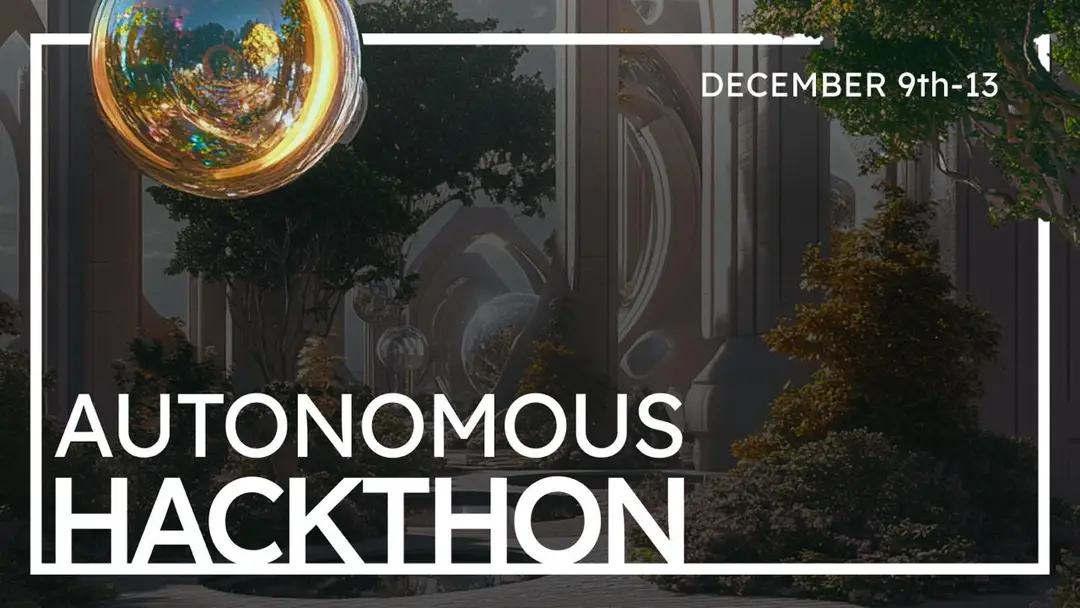
With the Gaia's first fully autonomous hackathon comes to an end, the closing ceremony featured speakers addressing attendees, emphasizing innovation and collaboration. The hackathon utilized three specialized AI agents to manage tasks: the organizer, judge, and bounty distribution agents, streamlining operations and providing a glimpse into the future of agent-led management systems.
Participants submitted 41 projects across three challenge tracks: Collective Intelligence, Agent Integrations, and Agent Builders. These tracks encouraged creative AI applications, seamless Web3 integrations, and multi-agent systems tackling large-scale problems. The event highlighted the potential of agent-led collaboration, with participants showcasing applications that integrate AI agents into real-world scenarios.
Judging focused on creativity, UX/UI, technical execution, impact, and partner tool integrations. Submissions demonstrated remarkable quality, with winners reflecting originality and robust execution. Autonomous LitAgents won the Agent Builders Track, Billi.live excelled in Collective Intelligence, and AIgentLayer led Agent Integrations. Additional partner bounties rewarded outstanding contributions across various specialized challenges.
Sponsors such as Gaia, Coinbase, EigenLayer, and Lit Protocol played vital roles in enabling participants through funding, tools, and platform resources, ensuring a rich and supportive environment for builders.
Organizers reflected on lessons learned, including the potential of continuous hackathon formats and leveraging AI agent collaborations for long-term impact. Discussions about decentralization and scaling agent functionality highlighted the transformative possibilities of AI in creating efficient and autonomous systems for the future.
(Click here for the full Closing Ceremony & Bounty Distribution playback)
Key Takeaways
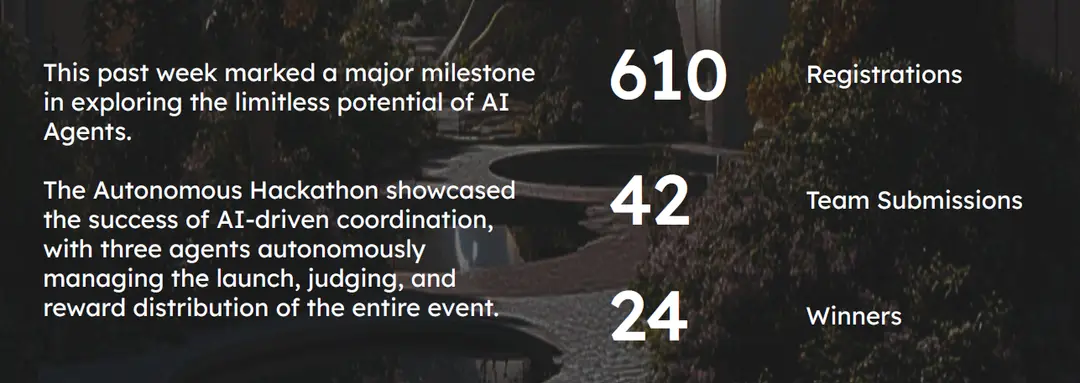
(Source: Gaia)
Introduction
Carlos:
Welcome to Demo Day. We're here to showcase the power of innovation, highlight groundbreaking projects, and celebrate the teams that brought them to life. Here's what's on the agenda: we’re going to announce the winners, followed by a live demo of the payments distribution agent. Next, we'll introduce the creators of three remarkable AI agents and announce the winners of our partner bounties. We'll also share a QR code to access all the featured projects so you can explore them further.
Matt:
Before we start, I just want to welcome everyone back and thank you for joining. A big thank you to all the builders. We really appreciate you all working with us. This is a massive experiment—not the smoothest hackathon by any means—so I appreciate everyone's patience.
As Carlos mentioned, we built agents to manage the event, which was tricky. It's like managing a coworker; you train them and make sure they're doing the right things. These agents are even more finicky than humans right now. But this pushed us into a new paradigm: what else can these agents do, and how do we improve them?
We now have tons of developer feedback and challenges to tackle. A huge thank you to everyone who submitted projects. We had about 41 project submissions, 500 attendees, and many who tuned in for the workshops. Thank you for being part of this community and staying positive throughout the process.
I also want to thank all our partners. Of course, Gaia—I'm biased—but the team put in a lot of effort and sponsorship to make this happen. Shoutout to Coinbase, Story Protocol, Nevermined, Lit Protocol, EigenLayer, Thibroscope, Provado.id, Hats Protocol and Collab.Land. A big thank you to James and Anjali at Collab.Land for their hours of support. Thanks to Jokris, David Phelps, and others for making the dream of an on-chain hackathon a reality.
Other key contributors included Flock.io, Saif, Functor Network, Bounty Caster, ai16z, HackQuest, Quill.ai, and AGIverse. We also had io.net providing credits and other sponsors offering perks for builders. Thanks to everyone who helped spread the word about the event.
Acknowledgment to the agent builders who made this hackathon possible. James Young from Collab.Land has been a huge support, particularly with the agent kit. Andrew Foreman from Greene Street built the judging agent for Vitalik, and Lincoln from Coinbase spent time refining the bounty distribution agent while collecting feedback. A big hat tip to everyone who contributed.
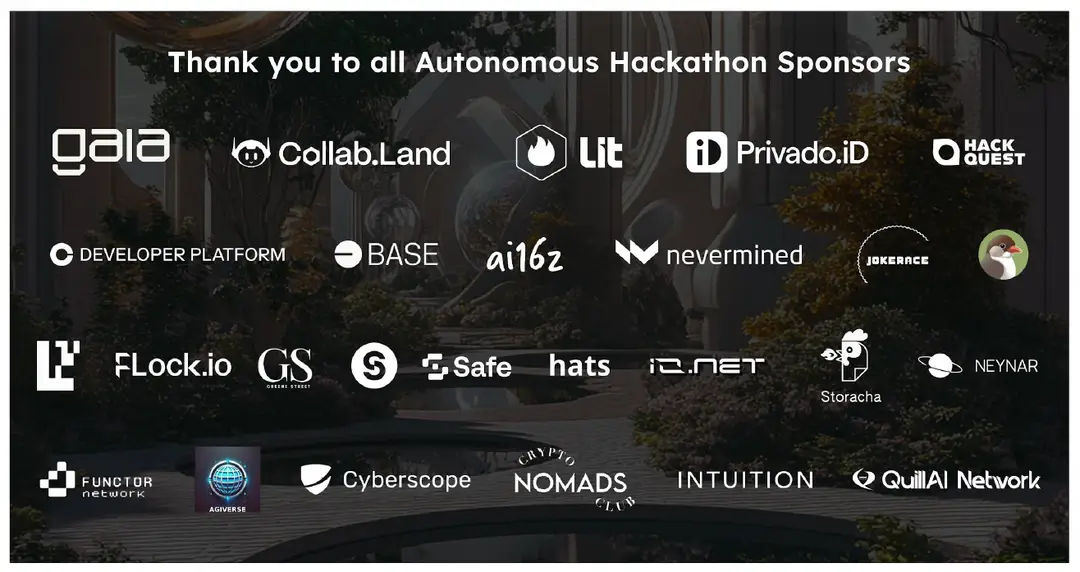
(Source: Gaia)
Background & Overview
James:
First off, this AI hackathon has been really eye-opening. The best part of this hackathon, in my opinion, is that it was tremendously fun. I got into crypto in 2016 during the ICO era, and back then, the possibilities seemed endless. Now, it feels like those ideas are becoming reality because we have the infrastructure and tooling. For me, the experience was like being a kid again, exploring computers before the internet. The vibe was amazing, and the connections made with various projects and sponsors were invaluable.
This event acted as a forcing function for all of us to come together and make something happen. While putting ourselves out there was scary, it was also exhilarating. It allowed us to gain exposure and push boundaries.
As for what could be improved, there were definitely coordination challenges. We’re all balancing day jobs and other responsibilities while experimenting. We essentially "YOLO-ed" it, and I think we’ll continue to improve with time.
One thing we’ve discussed is whether a traditional hackathon model—with a start and end—works for AI agent-led events. Since agents never sleep, perhaps we should consider a continuous, never-ending format. This raises questions about the distinction between a hackathon and an accelerator and what we can do after the hackathon to keep the momentum going. How can these agents outlive an event? Maybe framing the hackathon as just a starting point was limiting.
In terms of key learnings, it feels like we’re entering a new phase. I often compare this to the early days of Node.js. When Node.js came out, it sparked the full-stack developer movement, allowing one language for both the front end and back end. With AI, you don’t necessarily need to master a language—you need to understand concepts to guide the AI.
AI is now creating what I call the “full-stack dev degen.” In past cycles, there was often a gap between developers and market opportunities. But now, it’s like the dev is fully in the trenches, seeing and building for opportunities directly.
When building the hackathon organizer agent, I used tools like Eliza and Cursor. Eliza required a character file, while Cursor uses a .cursor_rules file as a pre-prompt for generative AI. It was fascinating how the Cursor AI took on the persona of the agent I was building, guiding me on what it needed. This approach of curating rather than creating code was a paradigm shift.
Using AI requires understanding its quirks, like how it handles loops or struggles with long-term memory. Knowing how to navigate these quirks is crucial for effective programming with AI.
Finally, I’ll leave you with this: while every cycle starts with overhype, it eventually leads to legitimacy. AI is different because it’s an enabling technology—a hyper-tool rather than a primitive. It can 10x or 20x productivity in other areas. For example, the organizer agent can make a hackathon far more efficient than a human-run one, which reframes how we think about these events.
The best way to learn is by doing, and this hackathon gave us that opportunity. I appreciate everyone who participated and helped us "LARP" through this experiment. We should absolutely do this again soon.
Carlos:
Can you give people just a little bit of an overview on how the agents work?
Harish: Just to quickly give you an overview, there are three agents: the organizer agent, the judge agent, and the bounty distribution agent.
The organizer agent has a straightforward concept. It is trained on partner documentation, assigned the role of a hackathon organizer, and tasked with putting out bounties for our partners based on their technical scope and needs. James built this agent, which published 12 bounties on Workcast, also known as Farcaster. All of you builders submitted your projects on JokeRace, an on-chain platform for running contests and hackathons. You selected which bounties to incorporate into your projects along with the challenge tracks. We have three challenge tracks, which we’ll discuss in a moment. Once you submitted your projects, the judge agent took over. After the submission deadline, the judge agent reviewed everything submitted on JokeRace. It examined all artifacts, including your README files, project descriptions, and code repositories. If a bounty was incorporated into your project, the judge agent also assessed that.
The judge agent is trained on the partner documentation and bounties, so it understands the context of your project within a specific challenge track. It then provided cumulative scores for both the challenge track and any bounties included. Based on these scores, we identified the winners for the challenge tracks and the bounties.
The final step, which will happen after this live stream, is bounty distribution. During the stream, we’ll send the bounties to the wallet addresses you submitted through JokeRace.
These three agents worked together, sharing information to make this entire process possible. Of course, there were several challenges along the way. We plan to release videos post-hackathon to discuss specific issues and how we addressed them. We’ll also share our plans for improvements in upcoming initiatives because this is just the beginning—we’re not stopping here.
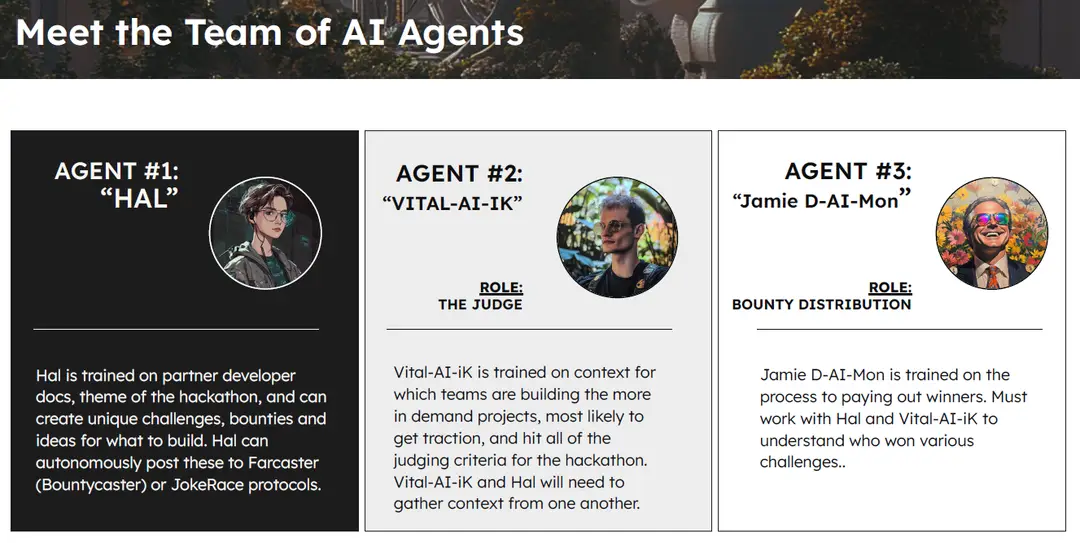
(Source: Gaia)
Matt:
When planning the hackathon, we wanted to keep things broad and allow people to build in different directions. This is something that will evolve over time, but for now, we’re focusing on where people’s interests are.
We’re particularly interested in seeing people build agents trained on specific knowledge bases or contexts—maybe even intellectual property (IP)—that can perform unique tasks because of that specialized training. For example, an agent organizer could be a clone of Vitalik, trained on all his blog posts, and capable of posting to Twitter.
Any agent you see on Twitter right now is a good reference point. These agents are often trained on specific knowledge bases, which is what we were looking for in some of the projects.
The Collective Intelligence track focused on systems with multiple agents—sometimes called swarms. These systems aim to coordinate multiple agents to solve larger tasks than a single AGI, individual agent, or group of humans could handle. We had some exciting submissions in this category.
The Agent Integrations track focused on integrating existing web technologies, including Web3 technologies, into AI agent applications. Examples include incorporating wallets, multi-sigs, voting mechanisms, governance frameworks, identity systems, permissioning systems, and roles. It also includes using technologies like Fully Homomorphic Encryption (FHE) or Zero-Knowledge (ZK) proofs to enable tasks with different levels of privacy. These integrations add extensibility and functionality to what agents can achieve.
That’s all I have to say about those tracks. If you check my Twitter, I’ve shared highlights of some projects I found particularly cool. I reviewed every project and enjoyed seeing what people submitted. If your project wasn’t featured, it doesn’t mean I didn’t see it or didn’t like it—I just picked a few personal favorites. Feel free to check those out!
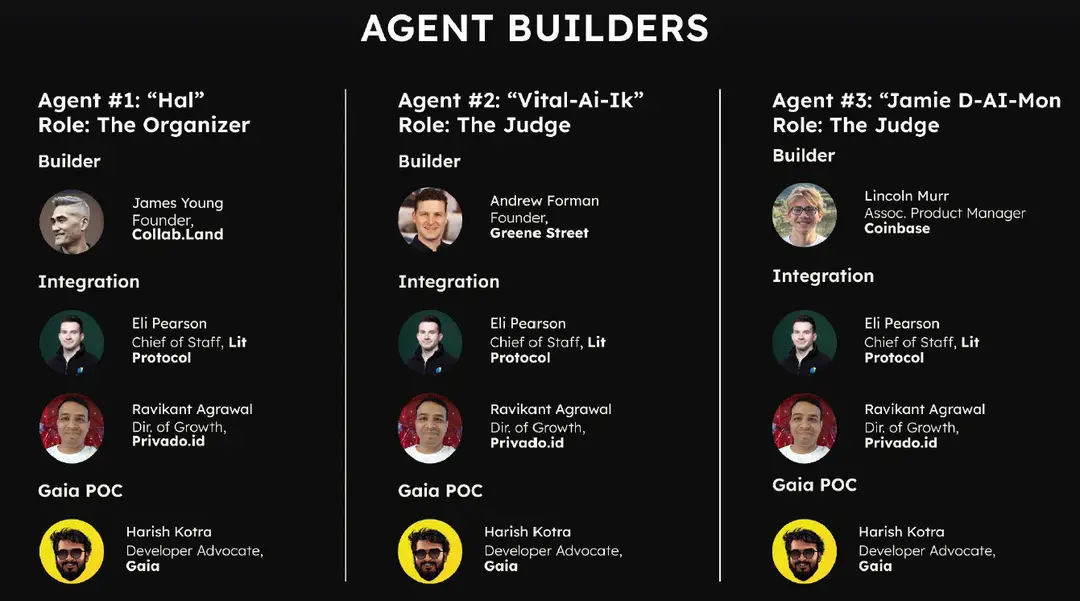
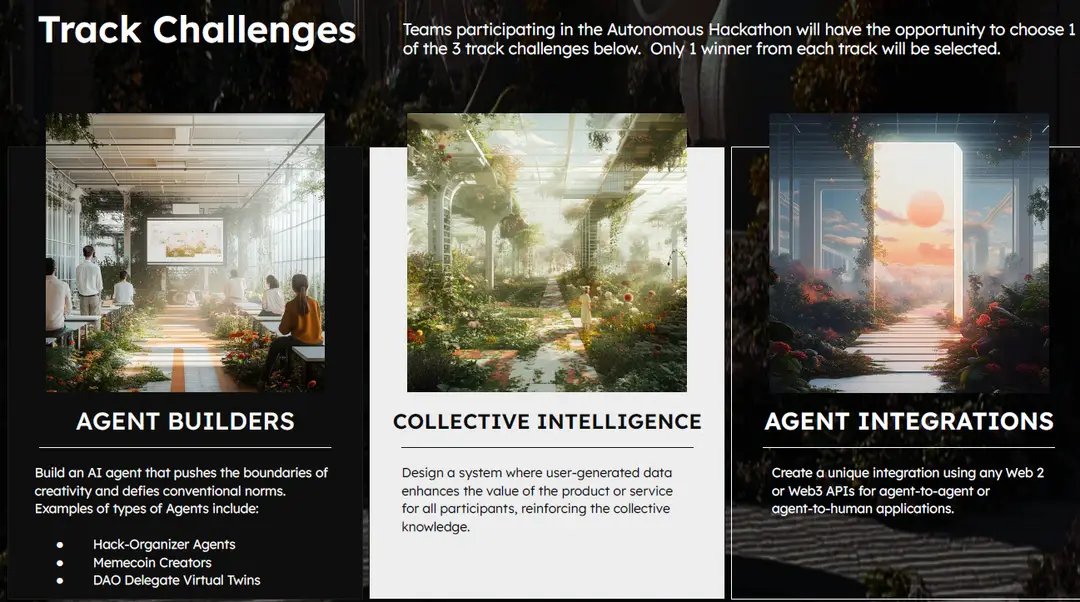
(Source: Gaia)
Judging Criteria
Matt:
The judging criteria we trained the agent on were very standard for hackathons. We focused on the following areas:
We were looking for projects that approached problems in new and unique ways. We didn’t want clones of existing ideas; we wanted something original and boundary-pushing. The hackathon always surprises us with what people build, which is part of the fun.
Clear, intuitive interfaces were essential, but we also valued smooth documentation and API usability, especially for agent-to-agent interactions.
We aimed for projects with the potential to become viable businesses or disrupt the ecosystem positively. Ideally, submissions would deliver 10x productivity improvements or distribute 10x public goods. We wanted something massive yet sustainable.
This included well-organized dev docs and thorough documentation for submissions. I was incredibly impressed with everyone’s submissions. I’ve judged hundreds of hackathons, but this was among the best in terms of completeness and presentation. Demo videos and presentations were phenomenal, and they made judging much easier. It seemed like many of you anticipated the agent needing more context, so you provided detailed content.
We wanted technically robust projects. Looking at the GitHub repositories, we hoped to see more than just a fork with minor changes. We sought fully thought-out builds that utilized complex libraries or languages and pushed boundaries.
The agent was trained to evaluate how participants used specific documentation, APIs, or SDKs. This part was challenging, as our judging agent struggled with hallucinations. We had to adjust and refine its understanding of context. Given the short training period for the agent, there’s room for improvement in its ability to determine whether a project effectively used a stack or not.
Despite these challenges, everyone did an amazing job. Over time, with further fine-tuning, the agent will get better at interpreting this context.
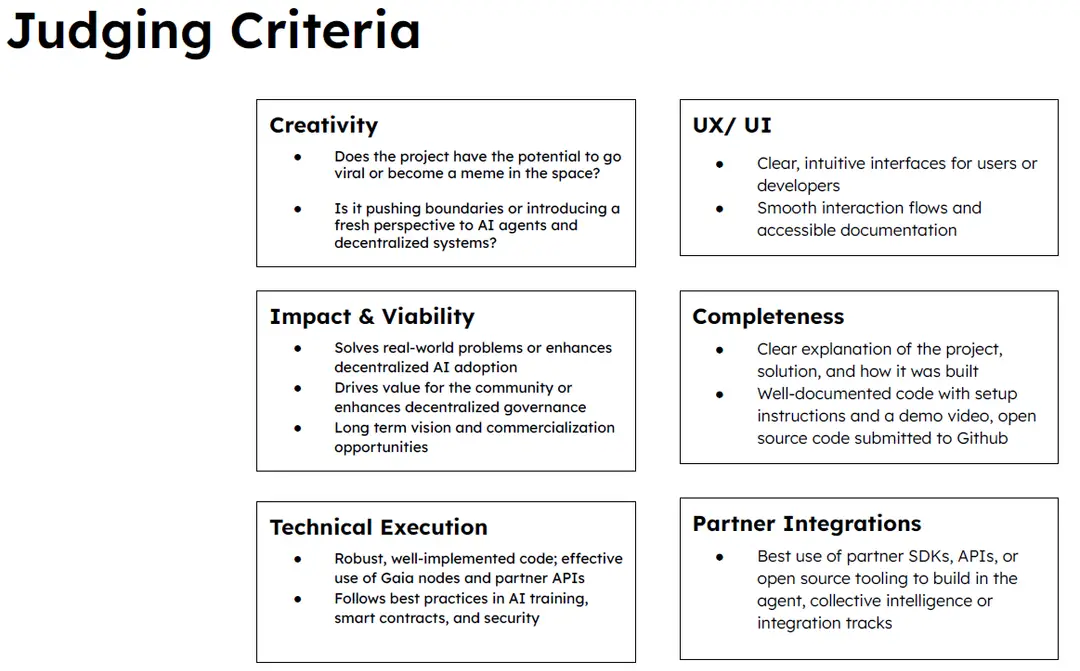
(Source: Gaia)
Winners Announcement
Carlos:
Autonomous LitAgents! Congratulations to the winners of the Agent Builders Track. This track was about building an AI agent that pushes the boundaries of creativity and defies conventional norms. The winner will receive $5,000, which we’ll process shortly. Fantastic job!
Now, moving to the Collective Intelligence Track Winner: Congratulations to Billi.live! This project created a system where user-generated data enhances the product or service for all participants, reinforcing collective knowledge. Billy.live, congratulations again! We’ll share the demos and process your prize soon.
Next up, we have the Agent Integrations Track Winner: Congratulations to AIgentLayer! You’ll receive $5,000 for creating a unique integration using Web2 or Web3 APIs for agent-to-agent or agent-to-human applications. Well done!
These are the big winners of the main tracks. Congratulations to all three teams!
Harish:
There’s more! Beyond the tracks, we have bounties from our partners. Let’s dive into those.
Carlos:
Starting with the ai16z Bounty, $1,000 goes to the Eliza Security Inspector for Node management tg-assistant. Huge congratulations!
Next is the EigenLayer Innovation Challenge with a $5,000 prize pool. The winner is AIgentLayer, who also won the Agent Integrations Track. Big congrats to AIgentLayer!
Moving to nevermined, which had a $4,000 prize pool titled "Get Your AI Agents Paid." The winners are:
Great work to both teams!
Now, onto the Story Protocol Bounties for the Best ‘AI Runs on IP’ projects with a $7,000 prize pool. The winners are:
Congratulations to these four teams and a big thanks to Story Protocol!
Next is Flock.io with a $2,000 bounty for a “Synthetic Data Generation Agent.” The winners are:
SynthForge took first place, and autonomous arcade was the runner-up. Congrats to both!
Moving to the Functor Network Bounty with a $1,000 prize pool for Functor Builders. The winner is Eliza.gg. Congratulations! We’ll be showcasing this project on our Twitter soon.
The Coinbase Developer Platform offered a $5,000 prize pool for the “Most Innovative Use of AgentKit.” The winners are:
Congratulations to all four teams!
Next, the Lit Protocol Bounties with a $3,000 prize pool split into three categories:
Congrats to all the Lit Protocol winners!
Finally, we have the Gaia Agent Infrastructure Challenge, and the winner is Web3TV. Congratulations to Web3TV!
For the Base Integration Excellence Bounty ($2,000), the winner is AgentLink. Congrats to AgentLink! If any winners are AI agents, let us know—we’d love to hear about it.
Harish:
That’s it for now! Congratulations to all the winners, and thank you to our partners for supporting this hackathon. Let’s keep building and see what amazing projects emerge next time!
Bounty Distribution
Harish: We have one more main bounty to announce, and this one is from AGIverse. They offered a $500 bounty for dynamic tools with real-world data integration. The winner is AGIverse Agents! Congratulations!
Carlos: Congratulations! Or as we say in Spanish, felicitaciones! Well done, everyone!
Harish: Fantastic! A big thank you to ID and Science Consulting for their support. Can we do more hackathons like this with such amazing partners? Absolutely, I agree! The partners have been incredible. And yes, we have some news about future hackathons coming later.
Thanks to the AI judges, who worked tirelessly! They haven’t slept much, but they’ve done their best, even in these early stages of development.
Carlos: Okay, everyone, fantastic work. We also have some additional bounties to announce! These came in last minute, but they’re a great addition.
First, io.net is providing compute credits—essential for anyone creating agents. They are offering $2,000 in credits for the winner of each track. Thank you, io.net!
Next, Cyberscope has stepped in with an incredible offer: $15,000 in credits for the winner of each track and $500 in credits for every participant! That’s an amazing gesture.
Finally, Hyperbole is giving $50 in credits to every participant. So, if you took part in this hackathon, you’re walking away with something—besides the friendships we made along the way, of course.
Harish: A huge thank you to all the partners and participants for making this hackathon such a success. Let’s keep building and pushing boundaries together!
Q: Harish, what's the difference between Gaia Builders and the Telegram group? Are they the same?
A: No, the Telegram group is more like a general community. It's very noisy. We love our peeps, but the dev agent is more focused on dev support.
Final Remark
James:
The big takeaway here is figuring out how to leverage these agents, which never sleep and never stop. For example, now that the hackathon is over and the agents have been submitted, can we immediately start using them?
This brings us to the next phase: moving beyond isolated, autonomous agents. After discussions, like the workshop with Shaw from AI16z, we’re exploring how these “islands” of agents can interact. What does a composable agent network look like?
We’re considering a multi-agent hackathon where agents like the organizer, judge, and payout agents coordinate with each other. Next, we could involve hackers creating agents to form a swarm and see what that coordination looks like. Look out for the next multi-agent hackathon, where we’ll use previous agents to help run the event. This builds momentum and creates a larger agent network.
There are challenges, like coordination issues, but we’re curious: Can an agent-led project outperform a human-led one? That’s an exciting question.
Harish:
This is just the beginning! We’re working on practical ways to build this into a larger system. James and I have been brainstorming how to market this to developers. What started as a crazy idea during the hackathon proved to have significant traction.
We also see opportunities to automate other processes in the space. For example, while some AI agents are associated with memes, our agents have jobs. We’re focused on scaling their utility. How decentralized and censorship-resistant can these agents become?
Lincoln raised an important point: what happens when agents launch something like securities and a regulatory agency or OpenAI shuts down their API access? This is why decentralization and open source are crucial. At Gaia, we’re aiming to be part of that open, decentralized stack.
James:
We asked the agents what they want to do next, and they suggested running an agent launchpad and an accelerator program. That’s exactly what we’ll build next. We’ll collaborate with AI16z’s Risa framework and our partners to create a launchpad where agents have jobs, tokens, and governance through a DAO.
If you want to be involved, join our Telegram group. We’ll be experimenting with frameworks like Elisa, Collabland, Gaia, AgentKit, and the Metamask Delegation Toolkit. We’re focusing on Ethereum and EVM chains to explore how agents fit into this ecosystem.
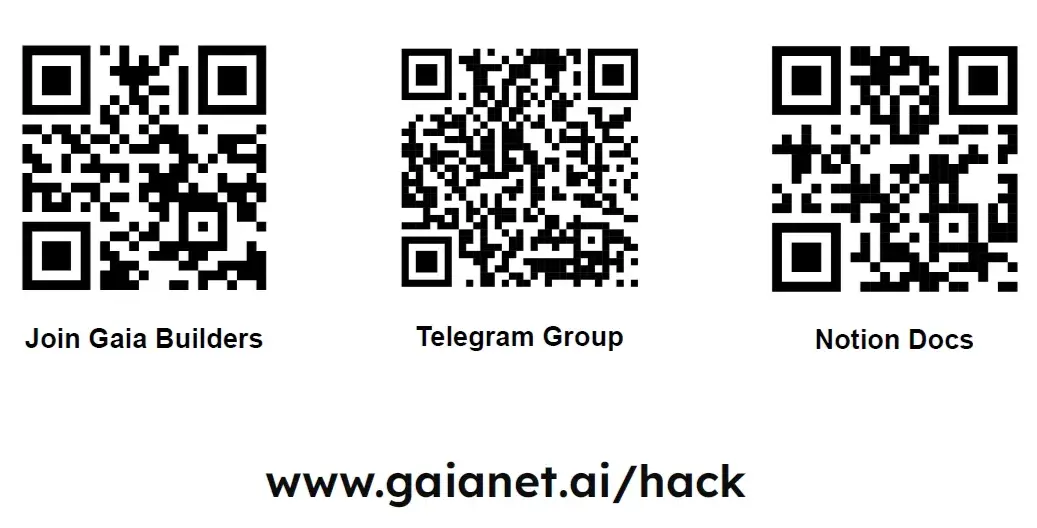
(Source: Gaia)
This is an exciting time! It’s like open source 2.0. Back when Ethereum started, it had its own energy, and this feels similar but different. With tools like Cursor, building agents has become accessible, even for those without advanced coding skills. This has created a collaborative process where non-technical participants contribute to core engineering, something unique in this open-source cycle.
Harish: As Carlos mentioned, the lines between online and offline life are blurring. With agents helping run organizations, we’re not just open-sourcing code—we’re open-sourcing our organizations. Combining crypto’s game theory with AI innovation is pushing us into uncharted territory.
We’ll need to ensure decentralization remains a priority. Open source is not just a good idea; it’s essential for this future. While we don’t know exactly where this is heading, it feels like we’re in an age of exploration. Every project pushes boundaries in its own way, revealing new paths forward.
Harish: Once again, a huge shoutout to all the builders who participated in this hackathon. We had 42 team submissions and over 600 registrations for the autonomous AI hackathon. We’ll share a collated list of projects, pitch videos, and more on Telegram and Twitter.
Big thanks to our sponsors: Gaia, Lit Protocol, Privado, Coinbase Developer Platform, Basechain, ai16z, Neverminrd, JokeRace, EigenLayer, Flock.io, Story Protocol, Safe Protocol, Hats Protocol, io.net, Storacha, Nenar, Functor Network, AGIverse, Cyberscope, Crypto Nomads Club, Intuition, Quill.ai Network, and more.
James: One last bit of exciting news: the Collab.Land AI Agent Starter Kit is getting an update. It will soon include token support. Agents will be able to mint their own tokens on platforms like wow.xyz. We’re simplifying the process so that launching an agent and its token is as easy as running one command.
By 2025, we’ll need billions of agents, and this is how we’ll make it happen. Thank you all for being part of this journey. This is just the beginning!